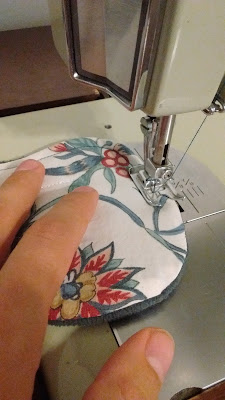{Buy my Cloth Pad Pattern HERE.}
1. the "topper"
2. the "core" or "absorbent core"
And,
3. the "backer"
The Topper
The topper is the fabric that goes against your skin.When I choose a topper fabric I like to stick with 100% cotton. Cotton is very absorbent and will soak up liquids right away. You don't have to use 100% cotton, though. You want to steer clear of material that is water repellent. I have heard of people using fabrics other than cotton including crushed velvet, which sounds very soft!
When choosing a topper fabric look for material that is comfortable. Cotton flannel is a good option because it is so soft. The only adverse thing about using flannel for a topper is that over time, and, after multiple washings, it tends to pill and look bedraggled.
When choosing a topper fabric look for something that is pretty, or speaks to you and your interests. :) If you like flowers, pick a print with flowers. If you like chickens, pick a print with chickens. If you are into music, find a print with treble clefs, notes, or even famous composers. You want to pick a fabric that is going to make you feel special. If you are the kind of woman who really dislikes having a period giving yourself something special to wear gives you something (albeit small) to look forward to.
Here is a picture of some topper materials I am going to up-cycle, just to give you some ideas. I found a pretty pillow sham and a flowery curtain (at the $5 Brown Bag sale I mentioned in Modifying A Silk Shirt) that are cotton. I also have some scraps of high end drapery material that I got at a Habitat For Humanity store, also, cotton.
The Core
The absorbent core is the material in the middle of the pad that does all the absorbing. It can be made of several layers of fabric for added absorption. 100% cotton is going to be the best up-cycling choice. Unless, you have some bamboo, hemp, or microfiber cloth diaper inserts laying around your house. Old towels are a great choice. They are super absorbent and hold a lot of liquid. Cotton flannel is another great choice.In this picture are a few examples of flannel that I am going to be up-cycling into absorbent cores for cloth pads.
I found a pair of XL flannel pajama pants at a Goodwill Outlet store. Flannel sheets and pillow cases are usually a bargain at thrift stores. This pillow case cost 50¢, and will make about 6 or 7 cores. And, as I mentioned, Terry cloth towels are an excellent core material.
The Backer
The backer is a material that needs to be water resistant. It doesn't have to be waterproof. That being said, some women do like the peace of mind of having a waterproof fabric between the core and the backer, specifically, a material called polyurethane laminate, PUL, for short. I am not going to go into the details of having a waterproof layer in this post because I am writing about using up-cycled materials that you have around your house. PUL is not found in most households. Most fabric stores carry PUL, though, in case you want to check that out.Not only should your backer be water resistant, but it should also not be slippery. The backer is the material that sets against your panties. If it is made out of a slippery material it will not stay were it is supposed to stay. You don't want your pads sliding around.
A good choice of material for the backer is polyester fleece. I have never heard of anyone using wool, but, it is water resistant and not slippery, so it may work well.
Here is a picture of some fleece jackets that I will be up-cycling. I found a couple at that $5 Brown Bag sale I mentioned earlier, and the one on the right is a fleece pullover that Mr. In The Mid-west has worn-out.
Preparing Upcycled Material
When preparing material for up-cycling there is no need to preshrink the fabric. Ideally, this fabric has been washed and dried countless times.
Although, you should wash items from the thrift store just to insure that they are clean.
Now we are ready to draft a pattern! Look for Up-cycled Cloth Pads {Part 2} for instructions on making your pad pattern.







I am your newest follower... I found you after you left a comment on my blog... Gentle Joy Photography. :)
ReplyDeleteThank you, Gentle Joy!
ReplyDeleteI have booked marked both of your blogs. I found them last night by way of The Modest Mom, Modest Monday Link Up. So far, I have really enjoyed your content! :)
I will right away take hold of your rss as I can't in finding your email subscription link or e-newsletter service.
ReplyDeleteDo you've any? Please permit me recognize in order that I may just subscribe.
Thanks.